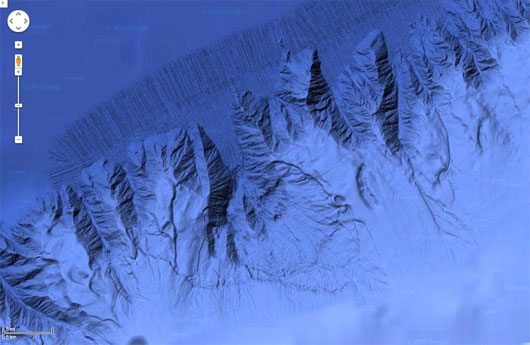The stone wall reveals the cause of the extinction of the dinosaurs
US scientists have mapped a large submarine cliff in the southern Gulf of Mexico, which is thought to contain clues to the extinction dinosaur collision millions of years ago.
According to NBC News, Campeche cliffs were used sonar wave by scientists at Monterey Bay Aquarium Research Institute (MBARI) in March 2013. With a length of 600km and a 4km slope at the bottom of the sea, the cliffs were chosen by scientists to study because it is located near the meteorite site that collided with Earth 65 million years ago.

Photo of Campeche cliff updated on Google Earth and Google Maps.(Photo: Google Earth)
Scientists believe that the impact caused a fire storm and dense dust cloud to cover the sunlight, leading to a global extinction event, ending 150 million years of dinosaur dominance on Earth.
Over time, these cliff sediments are divided into layers, the latest layer will be at the top. Studying the cliff sediments will help people better understand what happened in ancient geological activities, like in the Grand Canyon.
Chicxulub Crater, made up of a meteorite impact, is now aimed deep beneath the Yucatán Peninsula. Because of the limited conditions, scientists can only contact the crater Chicxulub through underground drilling activities through the peninsula.
In the future, the team will use underwater robots or submarines to collect sediments from the Campeche cliff, in the hope of clarifying the extent of the destruction of the ancient collision.
- Earth prospect when dinosaurs existed to modern times
- Looking for the cause of extinction of dinosaurs
- How dinosaurs dominate Earth? That era begins with the Great Extinction
- Dark matter is the cause of dinosaurs extinction?
- Meteorites make dinosaurs extinct
- Life of dinosaurs so far without extinction
- Dinosaurs are extinct because of cold
- Dinosaurs extinction is caused by meteors?
- What if dinosaurs live with humans?
- The cause of dinosaurs extinction
- Not only because of meteors, the main reason for the extinction of dinosaurs was unexpected
- Dinosaurs are the most 'black' creatures on Earth's history
 Is the magnetic North Pole shift dangerous to humanity?
Is the magnetic North Pole shift dangerous to humanity? Washington legalizes the recycling of human bodies into fertilizer
Washington legalizes the recycling of human bodies into fertilizer Lightning stone - the mysterious guest
Lightning stone - the mysterious guest Stunned by the mysterious sunset, strange appearance
Stunned by the mysterious sunset, strange appearance